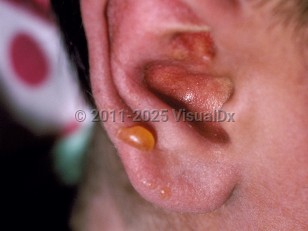Cutaneous GVHD has both an acute and a chronic form. The skin, the gastrointestinal (GI) tract, and the liver are the main organs involved in acute GVHD.
Classification of acute GVHD:
- Hyperacute – Onset occurs prior to day 14 following transplant. It manifests with high fevers and with more severe skin disease, lower response to topical steroids, and higher nonrelapse mortality compared to regular acute GVHD. Risk factors for hyperacute GVHD include mismatched related or matched unrelated donor, donor-recipient sex mismatch, a myeloablative conditioning regimen, and receipt of over 5 prior chemotherapy regimens.
- Classic acute GVHD – Starts less than 100 days after transplant (typically within 2-4 weeks of stem cell transplant). Skin involvement typically presents as a morbilliform eruption that may progress to erythroderma or, rarely, a toxic epidermal necrolysis-like illness; limited skin involvement is most common. The incidence and severity of the disease correspond with the degree of major histocompatibility antigen (MHC) mismatch between the donor and the host, but other key factors related to the development of acute GVHD include increased age of transplant recipient and sex mismatch between donor and recipient as well as the GVHD prophylaxis given to the stem cell recipient.
- Late-onset acute GVHD – Presents after 100 days.
There are 2 common grading criteria for acute GVHD, including the modified Glucksberg-Seattle criteria and the International Bone Marrow Transplant Registry (IBMTR) Severity Index.
Modified Glucksberg-Seattle Criteria:
- Grade I:
- Skin: rash covering < 25% of body surface area (BSA)
- Liver: bilirubin 2-3 mg/dL
- GI: diarrhea < 500 mL/day or persistent nausea
- Grade II:
- Skin: rash covering 25%-50% of BSA
- Liver: bilirubin 3.1-6 mg/dL
- GI: diarrhea 500-1000 mL/day
- Grade III:
- Skin: rash covering > 50% of BSA
- Liver: bilirubin 6.1-15 mg/dL
- GI: diarrhea 1000-1500 mL/day
- Grade IV:
- Skin: generalized erythroderma with bullae
- Liver: bilirubin > 15 mg/dL
- GI: diarrhea > 1500 mL/day or severe abdominal pain with or without ileus
- Index A: Mild skin involvement without significant liver or GI involvement
- Index B: Moderate skin involvement or mild liver / GI involvement
- Index C: Severe skin involvement or moderate liver / GI involvement
- Index D: Severe liver / GI involvement or multiorgan severe involvement
- Classic – Without preceding acute GVHD, develops more than 100 days after transplant (mean onset of 4 months). Sclerotic and nonsclerotic (lichenoid) skin lesions are most common.
- Overlap – Features of both acute and chronic GVHD occurring more than 100 days after transplant.



